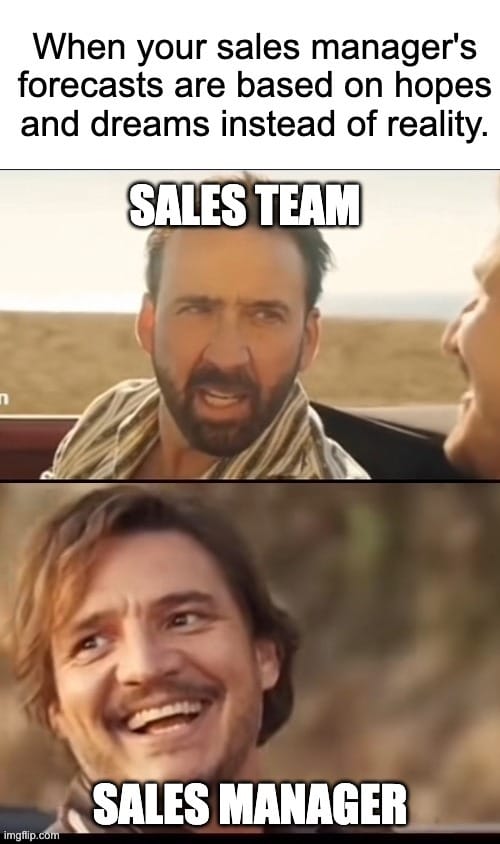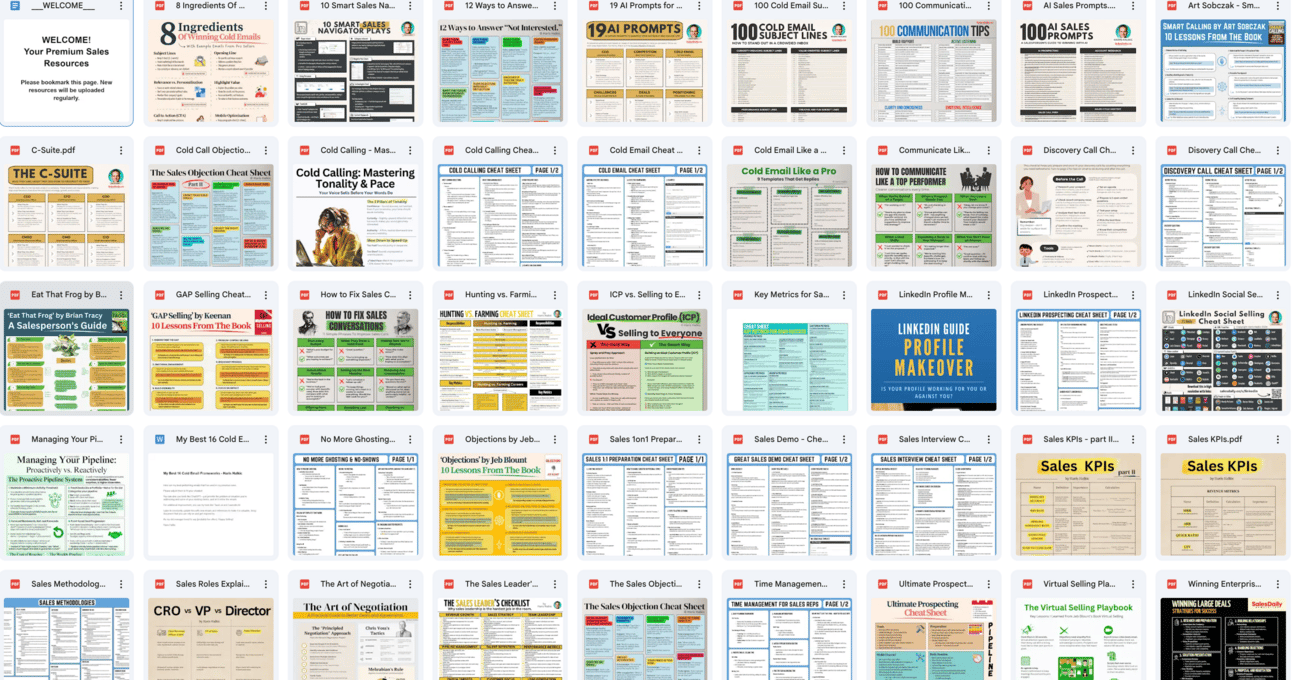- SalesDaily for Leaders
- Posts
- 🕹️ leadership mastery
🕹️ leadership mastery
[SalesDaily Leadership Edition] Consistency begin with leaders as example
Hi there,
Welcome to SalesDaily for Leaders: your weekly briefing packed with actionable insights to help you manage better, coach smarter, and drive results in B2B sales.
Every Sunday, I provide the latest strategies, resources, and ideas for leading high-performing teams and staying ahead in today’s competitive landscape.
Let’s dive in,
Haris
Event tip: Discover autonomous AI sales at the Agentic AI Summit
In today’s issue:
Sean Gentry: Make doing nothing the hardest option
Ben Ward: How new managers earn respect in 90 days
Mark Colgan: Sales enablement that double meetings
Leslie Venetz: Hidden mistakes block scalable revenues
SalesDaily Elite – Ready to Use Sales Content
Give your org immediate access to high-impact sales material that actually gets used: objection handling frameworks, outbound strategy breakdowns, and more.
✔️ Designed for trainings, onboarding, and internal delivery
✔️ Fully editable in Canva – brand your workflows together
✔️ Trusted by top sales coaches & high-impact sales group
Ideal for CROs, heads of enablement, and sales leaders.
Make doing nothing the hardest option
Sean Gentry points out that most deals aren’t stalling because of competitors - they’re dying because “no decisions” are made. Minimize your projects from getting delayed:
Build cost of urgency
❖ Emphasize their decision for staying with additional costs.
Example: “If you keep your current process for 6 months, you’ll lose $200K in productivity. Is that acceptable?”
❖ Finish by quantifying the impact of decisions.
❖ Make them realize waiting is the riskier option.
Make status quo uneasy
➤ Highlight what sticking using today’s process really costs.
Example: “Your team spends 15 hours weekly on manual tasks. Here’s how automating could free up that time for bigger priorities.”
➤ Display how painful staying is compared to solution relief.
Multi-thread every deal
✱ Deals need more stakeholders engaged for both sides.
• CFO → cost savings
• VP Ops → efficiency
• CEO → advantages
Example: If your champion is a Director of Sales, add the VP of Ops who hates inefficiencies, the CFO who cares about ROI, and the IT lead who will implement.
✱ Everything reinforces the need for perspective change
✱ The more voices pushing, the harder deals get stalled.
Build shared consensus
➔ Give stakeholders business cases for internal circulation necessities.
➔ A reference document keeps momentum alive when you’re not here.
Example: A one-page ROI summary that shows projected savings for finance, faster workflows for operations, and competitive advantage for leadership.
➔ Alignment builds when everyone sees themselves in business cases.
Ask for commitments
✔ Lower the risk of change with more next steps.
• “Can we schedule 30 minutes with your security team?”
• “Can you share those performance metrics tomorrow?”
✔ Small agreements builds momentum forward.
How new managers earn respect in 90 days
Ben Ward breaks down an effective step-by-step 90-day leadership plan that helps your new sales managers quickly earn trust, gain everyone’s respect, and drive better results:
Fixate over their goals
⇒ Managers start positions by pushing their own agendas.
The seven most important words in leadership: It’s not about you, it’s about them
Spend your first 90 days learning what each rep actually wants personally
Example: Instead of saying, “Here’s what I need you to do this quarter,” ask, “What do you want out of this role over the next year, and how can I help you get there?”
⇒ Everyone strives harder to achieve performance objectives.
Backbone of leadership
✱ Ward calls one-on-ones the single most powerful leadership tool.
✱ However, managers waste time by asking status updates instead.
✔ Schedule them consistently → Weekly or biweekly, never canceled.
✔ Start with “How are you?” → Start by meeting them where they are.
✔ Do everything in person → Read body language through video calls.
✔ Limit your workflows → Cap direct 1 on 1 at 10 reps. Delegate others.
✔ Follow the Jethro principle →Don’t try solving everything by yourself.
✔ Remain soft like a brick → Establish care first, then challenge directly.
Example: “I believe in you. That’s why I need you to stop going late to calls.”
✔ Use one-on-ones to fuel team meetings → If you’ve already uncovered blockers individually, group meetings can remain strategic instead of becoming complaints.
Example: A manager who skips this structure ends up spending team meetings on updates. A manager who masters one-on-ones uses those meetings to align on big moves, because personal issues have already been handled.
Lead with body models
➤ Most leaders are pushing on behavior.
➤ Instead, you have to strike at the root.
Mind → What’s their motivation?
Example: “I want to hit $500k by the end of this year.”
Heart → Why do they want it?
Example: “Because I want to pay off my student loans.”
Feet → What are they doing? Are they moving in the right direction?
Two scenarios:
If they’re flying in the wrong direction, corrections keep them aligned.
If they’re barely moving, reconnect using their hearts core objectives.
➤ The mind and heart always controls their direction.
Sales enablement that double meetings
Mark Colgan discusses how most SDR teams burn emails monthly with little to show for it. Turn waste into predictable systems that books meetings. Here’s a 30-day blueprint:
Week 1: ICP effective reset
↳ Most outbound groups target broadly.
↳ Chase the “most likely to buy” instead.
Examples of ICP reset:
⇒ Focus on mid-market companies that just raised Series B, not every SaaS company.
⇒ Target VPs of Sales in North America if that’s where solutions have been winning.
⇒ Build tiered-account lists: Tier 1 = must-win logos, Tier 2 = high-fit prospects, etc.
↳ Sales reps builds tighter checklists with higher landing.
Week 2: Message overhaul
❖ Generic “quick intro” templates are failing.
❖ Lead with specifics, and utilize light CTAs.
Examples of messaging shifts:
• Instead of: “I’d love 15 minutes to introduce our platform.”
Use: “{Competitor} minimize time by 40% after switching.”
• Instead of: “Do you have time for our demo this week?”
Use: “Is solving this something that’s on your radar?”
❖ Break emails into 2–3 sentences max.
❖ Always focus on the buyer’s problem.
❖ Pain-based messages are difficult to ignore.
Week 3: Timing changes
✔ Catch your prospects during a buying moment.
Examples of buying signals:
✱ A VP of Sales joins a new company ➔ they’re likely re-evaluating models
✱ A company announces $20M funding ➔ new budget currently expanding
✱ A CTO posts on LinkedIn about “manual reporting headaches” ➔ sign of pain
✱ A business firm installs Salesforce ➔ perfect timing for challenge integration
✔ Outreach from 14 days within trigger creates urgency and feels relevant.
✔ Stop looking in random inboxes. Connect message to what’s happening.
Week 4: SDR enablement
Reps need tools for great execution without constant feedbacks.
Examples of enablement in action:
➤ Objection handling scripts: “We already have a vendor.”
→ “That’s common. Curious, what’s working and what’s missing?”
➤ LinkedIn message frameworks: “Saw you just rolled out [tech]. Our clients often pair it with [solution] to save X hours.”
➤ Playbooks with everyday selling routines: 20 calls, 40 emails, 10 LinkedIn touches
→ Outbound becomes your powerful system
TO-GO
Leslie Venetz: Hidden mistakes block scalable revenues
Rich Adams: Difference between managers and coaches
Jason Bay: Pipeline consistency beats quarter-end tactics
Matt Green: Why vague expectations are delaying teams
QUOTE OF THE DAY
"Care enough to build value for customers. If you get that part right, selling gets easy."
PODCASTS
HUMOR




